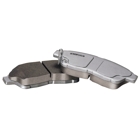Perhaps the most controversial aspect of the TrueDelta Vehicle Reliability Survey is that it excludes brand pads and rotors as wear items. Many people have legitimate complaints about pads that wore out too soon or rotors that required turning or replacement too often. So why not have them report this as an issue? Because defining what counts as “too soon,” given all of the variables in play (driving style, driving conditions) would require such a lengthy definition that hardly anyone would read it.
That said, I’m as much a fan of long-lasting brakes as anyone. And, because the front brakes do the bulk of the work, I’m always suspicious when the rear brakes need replacement before the fronts. As was the case with my Mazda this past summer.
 Turns out that the reason the rear pads wore out first is that they’re much thinner. How much did Mazda save by fitting a thinner pad? Couldn’t be more than 20 dollars, and probably much less. How much did it cost me to replace brakes that should have lasted at least 70,000 miles at 36,000? Ninety dollars, and that was with a sale at an independent shop. The dealer wanted 300.
Turns out that the reason the rear pads wore out first is that they’re much thinner. How much did Mazda save by fitting a thinner pad? Couldn’t be more than 20 dollars, and probably much less. How much did it cost me to replace brakes that should have lasted at least 70,000 miles at 36,000? Ninety dollars, and that was with a sale at an independent shop. The dealer wanted 300.
Today I read about the same OEM penny-pinching on a Mercedes-Benz E-Class that likely cost three times as much as my Mazda.
What does it say when a manufacturer is willing to cost the customer hundreds of dollars just two or three years down the road in order to save a few bucks up front?